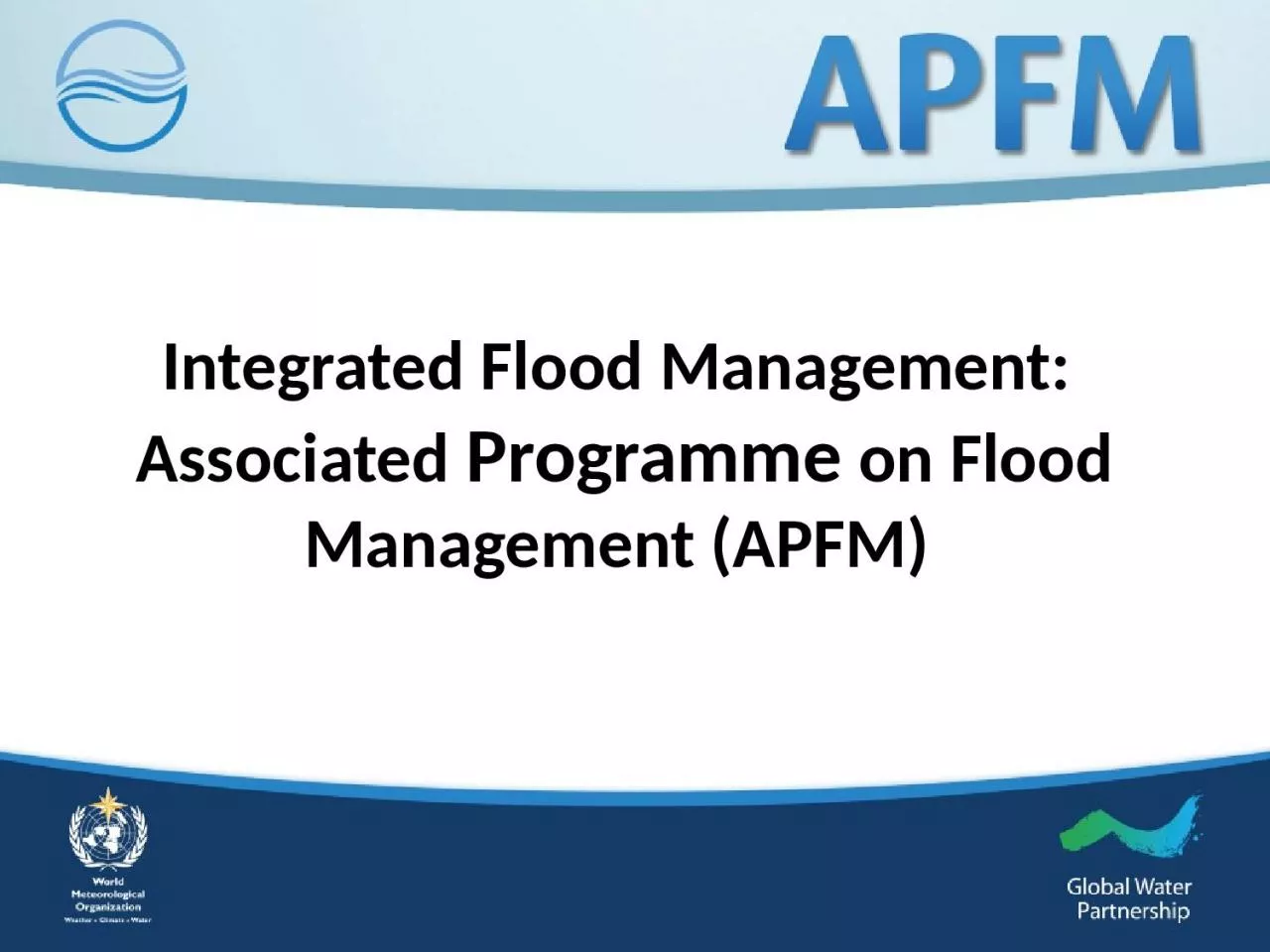

Associated Programme on Flood Management APFM Why is IFM necessary Source WMONo 1123 2014 Impacts of hydrometeorological and climatological hazards 19552014 3 Reduction of the number of victims thanks to greater effectiveness ID: 1015791
Download Presentation The PPT/PDF document "Integrated Flood Management:" is the property of its rightful owner. Permission is granted to download and print the materials on this web site for personal, non-commercial use only, and to display it on your personal computer provided you do not modify the materials and that you retain all copyright notices contained in the materials. By downloading content from our website, you accept the terms of this agreement.
1. Integrated Flood Management: Associated Programme on Flood Management (APFM)
2. Why is IFM necessary?Source: WMO-No. 11.23 (2014)
3. Impacts of hydrometeorological and climatological hazards (1955–2014)3Reduction of the number of victims thanks to greater effectivenessof early warning systems and prevention measuresHuman losses by decade(millions) Economic losses by decade(billions of US$ adjusted to 2013) Epidemics and insect infestations are not included
4. Why is the WMO involved in IFM?National Hydrological Services are responsible for:Providing services in support of national needs includingProtecting of life and propertySafeguarding the environmentContributing to sustainable developmentPromoting capacity-buildingActive involvement in the planning, development and management of water resources projectsWMO has a mandate to:Advocate for the widespread adoption of IFM at the basin, national and international levels (Resolution 20 (Cg-XV))Assist Members in flood management policy, strategy development, and capacity building
5. MissionTo support Members/countries in implementing Integrated Flood ManagementAssociated Programme on Flood Management (APFM)Joint Initiative Technical Support Unit embedded in the WMO Hydrology and Water Resources Branch Founded in 2001Contributors FOEN (Switzerland), MAE (France), CONAGUA (Mexico) and USAID (in the past: Japan, the Netherlands, Germany and Italy)
6. End-to-end (E2E) Flood Forecasting and Early Warning InitiativeREAL-TIME DATA COLLECTION MODELLING & FORECASTINGEARLY WARNING DISSEMINATIONRESPONSE TO WARNINGDECISION SUPPORTGlobal Hydrometry Service Facility (GHSF)Meteorological, Climatological and Hydrological (MCH) Database Management SystemFlash Flood Guidance System (FFGS)Coastal Inundation Forecasting Demonstration Project (CIFDP)Severe Weather Forecasting Demonstration Project (SWFDP)(APFM) Associated Programme on Flood Management DEWETRA PlatformPreparing for Extreme And Rare events in coastaL regions (PEARL)!In support of the functions of National Meteorological and Hydrological Services
7. Need to consider the water cycle as a whole and interaction with peopleA river basin is a dynamic system with many interactions/fluxes between land, water bodies and the atmosphereFlood Management is water management that is strongly linked to land management and peopleFlood and drought managementEffective use of watersGround water and surface water interaction in flood plains
8. Developers, Drainage authorities, Water/sewerage service providers, Insurers, Emergency Services, Local authorities, Strategic industries, Dam/reservoir operators, Irrigators, Farmers/Forestry, Environmental RegulatorsHydrometeorologyEngineeringSocial SciencesLawEconomicsPlanningProtection/PreventionEmergency ResponseReconstruction and RehabilitationInternationalNationalBasinLocalIFM is interdisciplinary, flexible and participatorySCIENTIFICDOMAINSSTAKEHOLDERS
9. DISASTERFlood Risk Mitigation:from theory to practiceDISASTERLack of information and preparednessElevated exposure due to uneffective (or absent) land use planningResidual riskHazardWarnings, civil defence planning, awareness raising and education to risk Structural measures (and maintenance), land use planning, basin managementFlood forecasting, flood mappingRisk sharing
10.
11. Promoting IFM to prevent the disaster from repeating itselfReducing risk exposure (flood risk management)Build back betterEnd-to-end early warning systemsAdvice on flood management through a HelpDesk Training , capacity building, and advocacy material Building a network of institutions supporting a multi-disciplinary approachHands on assistance to Members Project proposal preparationFlood risk management project implementationHow can APFM help?
12. MEMBERS/COUNTRIESSUPPORT BASERequest for assistance, preparation of project proposals, advice and supervision on implementationTechnical expertiseIntegrated Flood Management HelpDeskhttp://www.apfm.info/ifm-helpdesk
13. 30 Support Base PartnersSpecialized institutes in various disciplines relevant for IFM
14. Guidance MaterialsIntegrated Flood Management Concept PaperFlood Management Policy SeriesIFM Tool SeriesTraining ManualsPlus 22 Case Studies from Africa, Asia, Central & North America, Europe, South America and the South-West Pacifichttp://www.apfm.info/publication
15. What is needed?Identification of problems and gaps What is possible?Presenting existing capacities and opportunities Vocational training (short training and workshops for different target groups)Material on specific topics and contact with experts :Integrated flood managementUrban flood managementE2E EWS - Floods (under development)Community-based approachesDevelopment of National Strategies applying the IFM conceptAPFM Provides: Capacity building & trainingIFM for flood hazard mapping, JapanNational strategy on IFM, Lao PDRParticipatory risk assessment at Ban Buprham, ThailandMeasuring rain water from standard equipment installed at Ban Keomany, Lao PDR
16. Regional pilot projects Pilot projects have been undertaken in:South Asia (community-based approaches)Africa (flood management strategies)Central and Eastern Europe (flash floods)Available through the HelpDesk:Assistance in development of proposals Support in securing funding from donorsTechnical supervisionAim of pilot projects:Develop and implement IFM concept and its application through demonstration (with third party funding)
17. Success indicatorsLaunched in 2009Around 221 requests received from more than 40 countriesUsed by:NGOs and private sector Academic institutions Governmental agencies International Organizations
18. For more details:www.floodmanagement.infoThank you for your attention